Uses of vector Operators
As Gradient
Before defining and explaining gradient we need to know about differential operator (∆→) and scalar and vector field.
Vector differential operator ∆: Sir Hamilton first introduced the vector differential operator. Gibbs gave its name as ‘del’. Vector differential operator may be expressed in the following way:
del, ∆→ = [(∂/∂x) î + (∂/∂y) ĵ + (∂/∂z) ƙ]
It has vector properties like ordinary vector;
But; ∆→∆→ = [(∂/∂x) î + (∂/∂y) ĵ + (∂/∂z) ƙ] . [(∂/∂x) î + (∂/∂y) ĵ + (∂/∂z) ƙ]
= [(∂2/∂x2) + (∂2/∂y2) + (∂2/∂z2)] is a scalar quantity.
This operator is used to define the gradient of a scalar function, divergence of a vector function or curl of a vector function.
Scalar Field or Vector Field
Scalar field: Whatever field is considered, physical property is associated with each point of that field. If the physical property associated with that field is scalar, then that field is called scalar field. Density, temperature, potential etc are examples of scalar field.
Mathematically, φ (x, y, z) = 3x2yx + 2xy2x + 5 zy2 indicates scalar field.
Vector field: If the physical property associated with the field is a vector then that field is called vector field. Velocity, electric field, gravitational field etc are examples of vector field.
F→ (x, y, z) = ax2yx î + bx2yz2 ĵ + 4 zx2 ƙ indicates vector field.
Gradient
Let φ (x, y, z) indicate a differentiable scalar field. Then gradient of φ is expressed as ∆→φ.
i.e., grad φ = ∆→φ = [(î∂/∂x) + (ĵ∂/∂y) + (ƙ∂/∂z)] φ
= [(î φ∂/∂x) + (ĵ φ∂/∂y) + (ƙ φ∂/∂z)]













